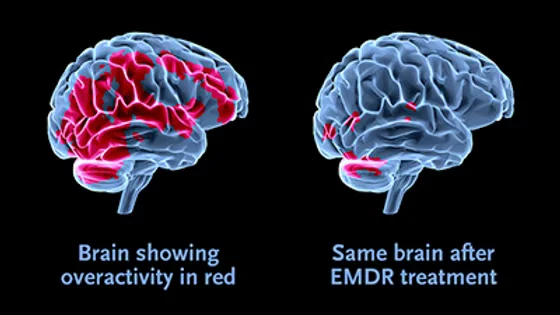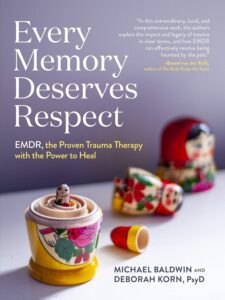Eye Movement Desensitization and Reprocessing (EMDR) Therapy
EMDR Therapy (Eye Movement Desensitization and Reprocessing) is a proven, evidence-based approach designed to help you heal from the lasting effects of trauma.
Trauma can leave deep imprints on your mind and body. It may cause overwhelming waves of fear, anger, or shame, often trapping you in a cycle of reliving painful memories. Trauma can disrupt your sleep, filling your nights with restless thoughts or haunting nightmares.
Sometimes, trauma stems from a single, life-altering event. Other times, it’s the result of ongoing challenges, like living with an abusive partner, enduring child abuse or neglect, or experiencing bullying. Whatever the cause, your struggles are valid, and healing is possible.
Developed by Francine Shapiro in the late 1980s, EMDR helps individuals process and resolve distressing memories by using bilateral stimulation, such as guided eye movements, tapping, or auditory tones. These stimuli are paired with the patient recalling traumatic events, allowing the brain to reprocess and integrate these memories in a less emotionally charged way. The goal is to reduce the lingering effects of trauma and help the individual develop healthier emotional responses.

Types of Trauma EMDR is Proven to Help
- Early Life Abuse and Neglect
- Physical Assault
- Sexual Assault
- Natural Disaster
- Violent Crime
- Accidents
- War
- Deaths
- Medical Procedures/ Surgeries
Other Mental Health Issues
ADHD
Anxiety
Addictive Behavior
Depression
Obsessive-compulsive disorder (OCD)
Personality Disorders
Recommended Reading

The Body Keeps The Score
“Traumatized people chronically feel unsafe inside their bodies: The past is alive in the form of gnawing interior discomfort. Their bodies are constantly bombarded by visceral warning signs, and, in an attempt to control these processes, they often become expert at ignoring their gut feelings and in numbing awareness of what is played out inside. They learn to hide from their selves.” (p.97)”

Every Memory Deserves Respect: EMDR, the Proven Trauma Therapy with the Power to HealYour Title Goes Here
Cowritten by a patient who experienced transformative relief from trauma through EMDR therapy, and a world-renowned psychologist who explains exactly how and why EMDR works, Every Memory Deserves Respect provides clear information while offering inspiration and hope.
Understanding the Science
Neuroplasticity
Neuroplasticity, or brain plasticity, refers to the brain’s remarkable ability to adapt its structure, functions, and connections in response to experiences, injuries, or environmental stimuli. This flexibility allows for lifelong learning, recovery from injuries, and adaptation to new circumstances. There are two main types of neuroplasticity: structural plasticity and functional plasticity. Structural plasticity involves changes in the brain’s physical structure, such as neurogenesis (the formation of new neurons) and the remodeling of neural connections. On the other hand, functional plasticity allows the brain to shift functions from damaged to undamaged regions. Synaptic plasticity (synaptogenesis), which includes the strengthening or weakening of synapses, is essential for learning and memory through mechanisms like long-term potentiation (LTP) and long-term depression (LTD). Real-life examples of neuroplasticity include learning new skills, such as languages or musical instruments, which can physically reshape the brain. Pioneering research by Marian Diamond demonstrated that environmental enrichment can lead to anatomical (structural) changes in the brain, highlighting its adaptability. These findings emphasize the potential for growth and healing in the cerebral cortex, particularly in the context of recovery from brain injuries (Post Traumatic Stress Disorder (PTSD) memories are a form of brain injury). Additionally, the discovery of brain-derived neurotrophic factors (NTFs are. molecules that guide neuron development) underscores the role of neuroplasticity in fostering resilience and recovery, revolutionizing our understanding of the brain’s capacity for lifelong growth and regeneration.
How EMDR Affects Neuroplasticity and Promotes Healing
EMDR therapy utilizes the brain’s ability to adapt and heal, known as neuroplasticity, to help individuals recover from trauma. This therapy employs bilateral stimulation—such as eye movements, sounds, or tapping—to target negative memories that are improperly stored in the brain. By doing so, it promotes neurogenesis (the creation of new neurons) and synaptogenesis (the process of creating new connections between neurons in the brain), allowing clients to access and reprocess, and appropriately store traumatic memories.
One crucial aspect for those who have experienced a significant loss is that making intense emotions more manageable does not diminish the memories of their loved ones or lessen the depth of their love. In fact, by reducing the intensity of these emotions, positive, often forgotten memories can emerge more readily because the negative emotions do not block them from surfacing.
Through accessing and reprocessing distressing memories, EMDR therapy takes advantage of the brain’s natural healing capabilities, fostering adaptive responses and facilitating lasting change. During EMDR sessions, new neural connections are established and integrated into existing networks. This integration is vital for turning fragmented traumatic memories into cohesive and adaptive memory networks, which support emotional regulation and overall well-being.
Research shows that EMDR can enhance connectivity among various brain regions, including the amygdala (which processes emotions), the anterior cingulate cortex (responsible for interpreting and controlling emotions, especially negative ones like pain, fear, and conflict), and the prefrontal cortex (which handles executive functions and emotional regulation). Improved connectivity within these areas helps disrupt the dysfunctional loops of trauma memories, allowing for more adaptive processing and emotional responses. As a result, EMDR therapy can quickly address the root causes of distressing symptoms, leading to more effective and lasting healing compared to traditional talk therapy.
EMDR Testimony
https://www.youtube.com/watch?v=lOkSm90f2Do
